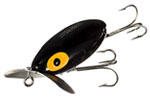
No thrill in angling can match that of a hungry bass chomping down on a surface lure the size of a rat. But finding such aggressively-feeding fish is unfortunately the exception rather than the rule. When bass are in a finicky, skittish mood or not aggressively feeding, jumbo surface lures often fail miserably.
The wariness is especially prevalent on hard-pressured waters, clear lakes and after a cold front pushes through, making bass sluggish and lethargic. It's also often common in summer, when young-of-the-year baitfish are the dominant forage available to the bass.
Why Going With a Small Fishing Bait Works
Largemouth fishermen have learned the value of turning to quieter, smaller offerings in these situations with mini-worms, light fishing jigs and scaled down jerkbaits. But for some reason, many anglers don't carry this miniaturization over to their surface lure fishing.
That's a big mistake. Over the years I've found small models of these topwater baits are often far more productive than standard or large versions. It's happened so often that now I typically start with the smallest or next-to-smallest offering a particular topwater lure comes in.
I can scale up larger if necessary. But it usually isn't. The small offerings, I've found, typically draw more action from average fish and just as many strikes from big bass, too.
Think of it. If you're hungry and there's a Whopper on the table, you'll eat it. But if a Junior Whopper was set in front of you instead, you'd probably eat that. And if you were in a sluggish, laid-back mood, the smaller burger might actually be more appealing.
When to Throw Tiny Surface Fishing Lures
Hard-pressured lakes and super clear waters are prime locations for tiny surface lures. Situations where the available forage fish are small and insects such as cicadas, grasshoppers and mayflies are present also argue for these mini lures.
Look for situations where bass are 6 feet deep or less. Flats, points, shoals, shelves, vegetation edges, stumps, rocks, riprap, docks and bridge pilings are all good targets. Also watch for fish lunging after bait on the surface.
My Choice for Topwater Baits
Four types of topwaters can be deadly on bass in tiny sizes. These include prop baits, stick baits, poppers and wobblers. Stock a selection of each of these in a few locally-proven color combinations.
|
Fishing With Stick Baits Why they work: Walking the dog is the classic way to fish stick baits. Just as it works with the Zara Spook, it works with smaller models such as the Puppy (3 inches) and Pooch (2 inches), as well as other companies' versions of these cigar-shaped lures. How to fish them: Hold the rod tip low and pump the bait with sharp, rhythmic jerks on a slack line, allowing pauses between the jerks. Also try twitching these lures in the smaller sizes near stumps or lily pads. Finally, try a steady, smooth retrieve like a snake swimming for cover. |
|
Fishing With Prop Baits
How to fish them: The splash of the propeller makes these lures easy for bass to locate if wind ruffles the surface. Cast and allow them to sit until the splash dissipates, then gently twitch the plug. Wait several seconds. Repeat. If this tactic doesn't produce, try steady pumping. |
|
Fishing With Wobbler Baits
How to fish them: Unlike most surface lures, these produce best when reeled back steadily to bring out the bait's enticing wobble. |
|
Fishing With Popper Baits
How to fish them: Work them with a rhythmic, pumping retrieve to start. If that doesn't produce, try light twitching so they just make a small disturbance on the surface. This is especially useful if the wind is calm. |
Tackle for Tiny Topwaters Fishing Lures
It's hard to get needed casting distance or manipulate these lures effectively with heavy bass gear. I prefer light spinning outfits with 6-10 pound monofilament or a light baitcast outfit with 10-20 pound braided line.
Use a rod of 6-7 feet with a flexible tip, but enough stiffness in the mid-section to drive the hook home in a 6 or 7 pound bass. As a final step, since bass often take these smaller lures deep in their mouths, I like to bend barbs down on these lures to reduce the chance of injuring fish that you want to release.
- 14299 views




